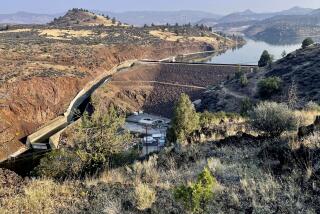Keep the Coast in Focus
- Share via
The barbed wire along a scenic stretch of coastline near San Simeon may come down soon, letting hikers and road-trippers linger as elephant seals lounge on the rocks and waves crash against the shore. A tentative deal reached last month between state officials and the Hearst Corp. would give the public title to 1,400 acres and 13 miles of shoreline surrounding Hearst Castle. The deal signals the Hearst family’s welcome retreat from grandiose plans it once pursued to carve up this stretch into homes for 65,000 and a luxury hotel and golf course.
Officials of the Wildlife Conservation Board and the Coastal Conservancy did the heavy lifting. Whether the public got the best deal possible is not clear because Californians have yet to see the fine print. Regardless, the California Coastal Commission should also be credited with a victory because Hearst lawyers began to negotiate in earnest only after the commission quashed a San Luis Obispo County development plan three years ago that would have allowed the company’s extravagant plans to proceed.
The agreement allows the Hearst Corp. to hang on to five miles of shoreline and build a 100-room hotel at San Simeon Point, on the coast. Hearst also could build 27 homes east of California 1. The state would take title to large stretches of seashore, get easements across other Hearst land and win guarantees that much of the company’s 120-square-mile cattle ranch would remain largely undeveloped. In exchange, Hearst would get $80 million in bond funds earmarked for open space purchases and $15 million in state tax credits.
A confidentiality agreement kept the negotiations under wraps for months, but during a series of hearings beginning this month the agencies involved will make the details public and take comment. Before approving taxpayer funds, they need to assure Californians that the appraisals of this property justify the purchase price, that the deal maximizes the public’s access and that planned homes will not be built in sensitive wildlife habitats.
These and other concerns notwithstanding, the Hearst deal came about because the Coastal Commission stayed focused on the task for which voters created it 30 years ago -- to preserve California’s seashore for the public rather than powerful landowners. That focus has made the commission the bete noir of coastal property owners.
It’s true that the panel can wrap even a simple garage remodel in miles of red tape, frustrating the most environmentally conscious homeowner. Still, the commission’s bottom-line insistence on public access set the parameters for the Hearst deal, as it has prompted other recent successes. The agencies now on the verge of closing the monumental Hearst Ranch deal must retain that focus on the public good.
More to Read
Sign up for Essential California
The most important California stories and recommendations in your inbox every morning.
You may occasionally receive promotional content from the Los Angeles Times.













